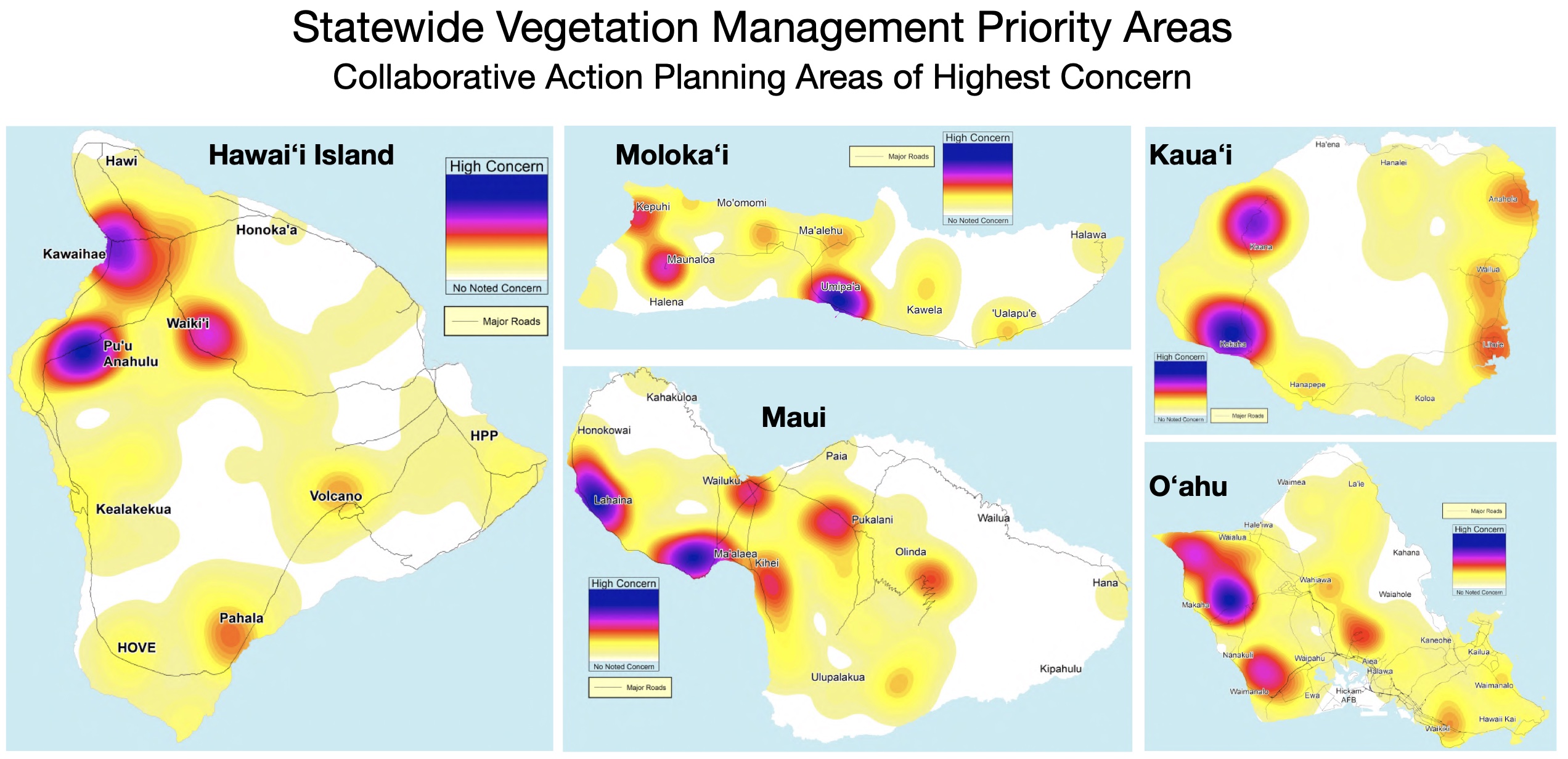“People in Hawaiʻi do a great job of coming together after these disasters,” Jeremie Makepa said, referring to the Maui conflagrations, the most recent disaster. “But we don’t do very well before them. We do a lot of stuff in defense… We don’t do enough to be pro-active.”
The remarks of Makepa, a fire captain on Kauaʻi, were made during his presentation in a “talk-story” webinar sponsored by the Pacific Fire Exchange, a joint program of the University of Hawaiʻi at Manoa and the Hawaiʻi Wildlife Management Organization (HWMO). The organization he helped establish on Kauaʻi, ʻAina Alliance, has initiated a wide-ranging fire-hazard reduction project on nearly 500 acres of Hawaiian Homelands at Anahola, involving trash removal, fuel load reduction, and building firebreaks.
Robbie Justice, another participant in the webinar, described how a consortium of organizations established a two-mile-long firebreak in the Big Island district of South Kohala along Highway 19, which links the towns of Waimea and Kawaihae. Justice works for Forest Solutions, a company that manages thousands of acres of land on the Big Island. Other participants in the effort were the Queen Emma Land Company and Parker Ranch.
The firebreak followed along a utility access roughly parallel to the highway. It was cleared of invasive grasses and koa haole and widened to 30 feet, then treated with pre-emergent herbicide to suppress regrowth.
Clearing involved the use of cord trimmers, since any blade hitting the rocks could have caused sparks, Justice said. No heavy equipment was used to avoid any sediment running into Pelekane Bay, he added.
In August, as wildfires were forcing evacuations in residential subdivisions in Kohala, the Queen Emma lands were spared – although Justice says flames came as close as half a mile.
The efforts of Justice and Makepa and dozens of other landowners, communities, and groups across the state owe much to HWMO, which for years has found grants and fostered alliances that, it is hoped, mitigate or reduce the effects of wildfire.
One of the organization’s fire-pre-emptive projects is advising communities on how residents can reduce wildfire risks and earn “Firewise” designation from the National Fire Protection Association. Across the state, 14 communities or neighborhoods have earned Firewise status, with five more either pending renewal or in still completing the process. Three of the communities are in Maui: Launiupoko (near Lahaina), Kahikinui (on the dry south side of the island), and Waiohuli (in the Kula area), all of them having earned Firewise status in 2016. On the Big Island, several of the Hawaiʻi island Firewise communities were near the August fires, including some of those under evacuation orders. None of the homes in any of the Firewise areas were burned.
Several years ago, HWMO undertook a rapid mapping assessment of all the inhabited Hawaiian islands except Niʻihau, looking at wildfire hazards and fuel reduction efforts and developing lists of priorities to reduce the likelihood of wildfires or mitigate the damage from them.
Across the board, HWMO found policies and funding related to fire infrastructure and vegetation management were insufficient. Participants in the island-specific planning workshops “overwhelmingly” identified as their top priority the need for the Legislature to create a program providing “consistent funding for projects on a longer-term basis that are reflective of Hawaiʻi’s multiple growing seasons.”
In the 2023 session, the Legislature failed to approve s measure that would have allowed the Division of Forestry and Wildlife to establish a community fuels reduction project. The measure, Senate Bill 409, was effectively killed by Rep. Kyle Yamashita, chair of the House Finance Committee.
Environment Hawaiʻi asked Yamashita why he killed the bill.
SB 409, he said in a written response, would have “appropriated an unspecified amount of general funds to … DOFAW for a community fuels reduction project” and also require DOFAW to account for the program “as a separate line item in its budget.”
But, he went on to say, that “would have limited departmental flexibility in allocating funding provided by the Legislature.
“In most cases, the House Finance Committee supports allowing departments whose staff hold expertise in running effective programs the flexibility to allocate financial resources as deemed most appropriate.”
As for the funds, the original measure did specify $1.5 million in general funds to go toward the fuels reduction project. But “a simple appropriation to the program is more appropriately addressed via the budget to assure continued funding.”
The Legislature has supported fire prevention activities, he went on to say, as reflected in budget allocations to the Department of Land and Natural Resources’ account for native resources and fire protection, known in the budget as LNR402.
“Over the years, LNR402’s general fund budget has increased from $4.7 million in 2015 to $17.4 million in 2024, an increase of roughly 270 percent in less than a decade,” Yamashita stated. “The Legislature also increased the base budget for fire resources in the Division of Forestry and Wildlife by $1.8 million in 2022. Additionally, the state is expected to receive more federal funds for fire prevention, including the Community Wildfire Defense Grant, which recently awarded DLNR about $350,000 for fire prevention activities.
“The disastrous wildfires on Maui make it clear that even greater attention needs to be paid to mitigating fire risks in and around our communities, especially as climate factors make these types of storm events more and more likely. We are committed to continuing to strengthen fire prevention resources for the state.”
Yamashita represents House District 12, which includes Pukalani and Olinda, two of the Upcountry Maui communities devastated by the August fires.
— Patricia Tummons


Leave a Reply